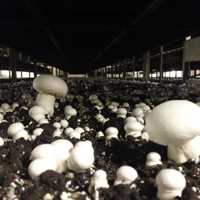Evaluation of energy requirements of an industrial scale plant for the cultivation of white button mushroom (Agaricus bisporus)

Published:18 June 2020
Abstract Views: 2275
PDF: 2206
HTML: 2454
HTML: 2454
Publisher's note
All claims expressed in this article are solely those of the authors and do not necessarily represent those of their affiliated organizations, or those of the publisher, the editors and the reviewers. Any product that may be evaluated in this article or claim that may be made by its manufacturer is not guaranteed or endorsed by the publisher.
All claims expressed in this article are solely those of the authors and do not necessarily represent those of their affiliated organizations, or those of the publisher, the editors and the reviewers. Any product that may be evaluated in this article or claim that may be made by its manufacturer is not guaranteed or endorsed by the publisher.
Similar Articles
- Gabriella Impallomeni, Francesco Barreca, Agrivoltaic systems towards the European green deal and agricultural policies: a review , Journal of Agricultural Engineering: Vol. 56 No. 1 (2025)
- Farid Tamhidi, Morteza Almassi, Mohammad Ghahderijani, Hossein Bakhoda, Evaluating the efficiency of energy use in cultivation of medicinal plants: a case study on garden thyme and peppermint employing life cycle assessment and support vector machine modeling , Journal of Agricultural Engineering: Vol. 56 No. 1 (2025)
- Behrooz Behboodi, Mohammad Gholami Parashkoohi, Davood Mohammad Zamani, Saeed Firouzi, A study comparing energy consumption and environmental emissions in ostrich meat and egg production , Journal of Agricultural Engineering: Vol. 56 No. 1 (2025)
- Farshad Haghjooy Maklavani, Mohammad Gholami Parashkoohi, Davood Mohammad Zamani, Hamed Afshari, Investigating the impact of integrating land consolidation with agricultural mechanization on the technical, energy, and environmental dimensions of paddy production , Journal of Agricultural Engineering: Vol. 56 No. 1 (2025)
- Francesco Barreca, Giuseppe Modica, Salvatore Di Fazio, Viviana Tirella, Raimondo Tripodi, Carmelo Riccardo Fichera, Improving building energy modelling by applying advanced 3D surveying techniques on agri-food facilities , Journal of Agricultural Engineering: Vol. 48 No. 4 (2017)
- Marco Fiala, Jacopo Bacenetti, Model for the economic, energy and environmental evaluation in biomass productions , Journal of Agricultural Engineering: Vol. 43 No. 1 (2012)
- Alexandros Sotirios Anifantis, Simone Pascuzzi, Giacomo Scarascia-Mugnozza, Geothermal source heat pump performance for a greenhouse heating system: an experimental study , Journal of Agricultural Engineering: Vol. 47 No. 3 (2016)
- Alvaro Marucci, Adolfo Gusman, Barbara Pagniello, Andrea Cappuccini, Limits and prospects of photovoltaic covers in Mediterranean greenhouses , Journal of Agricultural Engineering: Vol. 44 No. 1 (2013)
- George Ashwehmbom Looh, Fangping Xie, Xiushan Wang, Augustine Ngiejungbwen Looh, Hamdaoui Hind, Grain kernel damage during threshing: a comprehensive review of theories and models , Journal of Agricultural Engineering: Vol. 56 No. 1 (2025)
- Francesco Barreca, Pasquale Praticò, Giuseppe Davide Cardinali, A low-energy storage container for food and agriculture products , Journal of Agricultural Engineering: Vol. 52 No. 3 (2021)
You may also start an advanced similarity search for this article.

 https://doi.org/10.4081/jae.2020.1000
https://doi.org/10.4081/jae.2020.1000 










